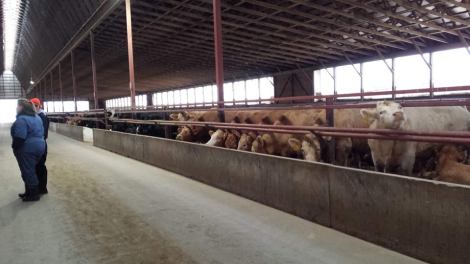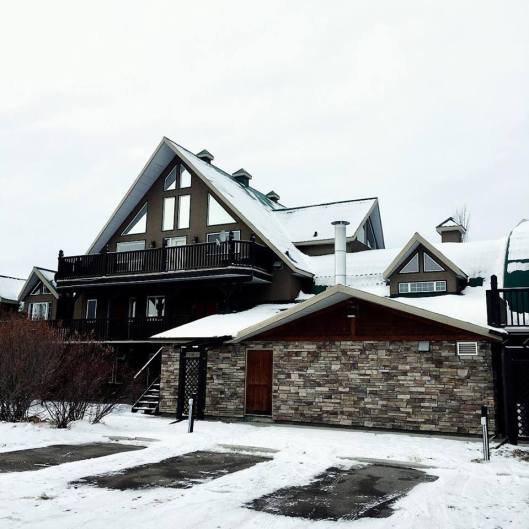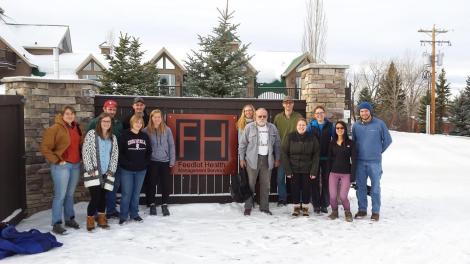In November I was lucky enough to take part in the Beef rotation at OVC, which is a popular rotation among food animal students. It’s a 2 week rotation, with the first taking place in Gueph, and the second week is at Feedlot Health Management Services in Okotoks, Alberta.
 During our first week we reviewed the common diseases of beef cattle, as well as the structure of the beef industry in Canada and North America. Then we got to tour an Ontario feedlot, a cow-calf operation, and a stockyard (where weaned cattle are processed and sent to the feedlot where they will be finished). It was great talking to producers and learning about the challenges and day-to-day things they deal with. The beef industry isn’t huge in Ontario, so it was pretty invaluable to get to see these facilities. One of the feedlots had a steam-flaker for their corn, which gelatinizes the corn and makes it more digestible (less food waste!), which was really neat to see. We also saw one out west that did the same to barley.
During our first week we reviewed the common diseases of beef cattle, as well as the structure of the beef industry in Canada and North America. Then we got to tour an Ontario feedlot, a cow-calf operation, and a stockyard (where weaned cattle are processed and sent to the feedlot where they will be finished). It was great talking to producers and learning about the challenges and day-to-day things they deal with. The beef industry isn’t huge in Ontario, so it was pretty invaluable to get to see these facilities. One of the feedlots had a steam-flaker for their corn, which gelatinizes the corn and makes it more digestible (less food waste!), which was really neat to see. We also saw one out west that did the same to barley.
As you can see from the pictures, Ontario feedlot cattle are raised indoors for the most part, although there are some that get to spend the summer on pasture. Cow-calf operations offer usually a mix of pasture and shelter. Our winters/springs are just too wet to allow for healthy cattle that grow economically. Beef cattle are certainly hardy, but being wet and cold is a terrible combination! As you’ll see, this is in stark difference to the feedlots out west, which are out in the open due to the dryness of the winters/springs out there.

During our week in Ontario, we also visited one of the auction markets where many beef cattle are sold. The North American beef industry is so variable – prices change week to week and it makes for an unpredictable situation for producers to make profit. Vets who work with beef producers have to have a sense of this in order to work together to maximize cattle health and make sure the producer doesn’t lose money. We got a ton of economics during our week out west, but this was a good introduction to get a sense of what cattle were selling for at the current time. 
Then we were westward bound! Okotoks is just south of Calgary, and we were starting our scheduled rotation on the Sunday of the second week. Feedlot Health Management Services (FHMS) is an impressive facility with a unique business model. They run 3 one-week rotations during November which hosts students from all over Canada and the US. Our week consisted of our group from OVC, a group from Cornell, and individual students from Calgary, Washington State, and Oregon. Our days were packed full of activities and lectures, so we had long days, but it was a lot of fun.

The front of FHMS
We got to learn about economics, nutrition, population medicine, as well as using research to inform good protocols for treatment. We also had a ton of fun doing post-mortems and seeing lots of common feedlot diseases. My group got to do some bloat and castration surgeries (see slideshow below), which was a lot of fun too. One of the best things we got to do was go “pen-checking.” Feedlots have designated pen-checker employees that ride or walk each pen every day and pull any cattle that are sick and require treatment. It’s quite the art form – you want to catch issues early, but you don’t want to pull too frequently because it stresses the cattle and may cause more harm than good. I got to do it on horseback which was fun (and freezing) and I was so impressed with the abilities of the pen-checkers to make these important decisions.
The scale of these feedlots is just way beyond any of the feedlots in Ontario. Some of them have 50 000 head of cattle. There was a pile of silage (used for feed) on one of the feedlots that was 102 000 tonnes. Sometimes it was just mind-blowing.
 We also got to go to one of the Alberta cattle auctions (see picture) and do an exercise in buying cattle. We got to simulate a buyer, we had a budget, and got to fake buy cattle. This was of course a competition to see who could make the most money – we calculated the price of what it would cost to finish an animal bought at which weight and then how much we would make off that animal at slaughter, and came up with our end profit. We also had to figure out which prices were too high and would result in an end deficit, so you’d know which groups of cattle not to buy. When we did this live, it was pretty insane and could be hard to keep up and make snap decisions! We were ranked by our profits and the list was posted in the kitchen of the practice… I was happily in the middle of the pack and didn’t lose money!
We also got to go to one of the Alberta cattle auctions (see picture) and do an exercise in buying cattle. We got to simulate a buyer, we had a budget, and got to fake buy cattle. This was of course a competition to see who could make the most money – we calculated the price of what it would cost to finish an animal bought at which weight and then how much we would make off that animal at slaughter, and came up with our end profit. We also had to figure out which prices were too high and would result in an end deficit, so you’d know which groups of cattle not to buy. When we did this live, it was pretty insane and could be hard to keep up and make snap decisions! We were ranked by our profits and the list was posted in the kitchen of the practice… I was happily in the middle of the pack and didn’t lose money!
We also got to see some of the beautiful views of Alberta – my group was in the foothills of the Rockies on one of our days, and we also got to see a bunch of mule deer.


All in all, it was a great week full of invaluable information! The vets at FHMS are really excellent at what they do, and they are passionate about what they teach. I felt like I was learning something new every 5 minutes. Even though we don’t have many feedlots in Ontario, many of the skills and lessons were easily transferable to other types of practice.

The whole group for our week at FHMS
We then headed back to Ontario to grudgingly write our NAVLEs (North American Veterinary Licensing Exam) in the warmer, wetter weather.

The OVC Crew and our great supervisor, Dr. Dave Renaud

Pingback: Rotation Recap: Part 1 | Shannon Finn: Student Veterinarian·